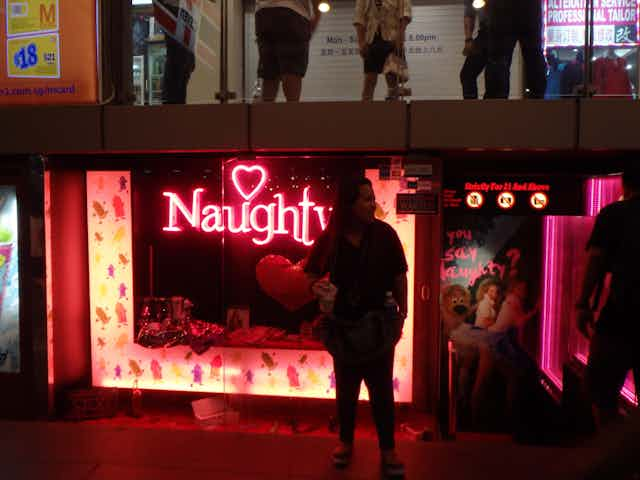Increasingly liberal attitudes to sex have allowed for greater public celebration of sexual diversity, but the desires of heterosexual men still dominate urban environments.
Neighbourhoods where brothels, peep shows, strip clubs and sex shops cluster, dubbed “sexual entertainment districts”, have become common in neoliberal cities. A closer look at these areas, which concentrate in the CBD of older cities and the outer suburbs of younger cities, reveals how entrenched gender inequalities materialise in urban spaces.
Most critiques of sexual entertainment precincts, also known as “vice districts”, focus on the rise of crime and the decrease in nearby property values. We rarely discuss the possible effects of these precincts on the female population’s urban experience.
Strip clubs pose a particular conundrum, as they’re not subject to the same restrictions as, say, brothels. In Australia and the UK, the first legal strip clubs opened in the 1990s. Since then, commercial sex has rapidly increased its presence.
In parallel with more open legislation, strip clubs operate with a certain flexibility. Unlike brothels, they can advertise in mainstream media and are licensed to serve alcohol to patrons. With an estimated global revenue of US$75 billion, the strip club industry has established itself as an urban economic force. But at what cost?
A report by the Coalition Against the Trafficking of Women found alcohol consumption in strip clubs creates a significant risk to the safety of nearby women. The report suggests alcohol licensing has direct impacts on community control of stripping venues and leads to no-go zones for women.
Plan International Australia’s recent interactive mapping project, Free to Be, found women deliberately avoid the entire length of King Street, Melbourne’s main strip club precinct. Project participants reported that any woman in the area was considered to be open to sexual propositions from strangers.
Anecdotal submissions to the Free to Be crowdmap included statements such as:
Men think that because you’re on King Street, you must be a stripper or hooker.
It’s like open rules here, cat calling, harassment and open hostility.
Plan International Australia’s data indicate that Melbourne women have internalised the link between the strip club precinct, the assumption that any woman in the area is “up for sex”, and the normalisation of hyper-masculine violence.
To reduce the risk of harassment and assault, more and more women feel forced to modify their movement throughout the city – especially during the night and early mornings.
This is not only limited to Australia – it’s a global issue.
UK organisation Object also reported that the presence of strip clubs creates zones where women’s “sense of security and entitlement to public space” are reduced.
In this context, public infrastructure and transportation areas like bus stops become sites of harassment, intimidation and other anti-social behaviour.
Exploitation beyond the club walls
It’s vital to understand how the behaviour and power relationships inside sex industry businesses like strip clubs influence social interactions outside.
My latest research suggests that the exploitation of women entrenched in the stripper-and-client relationship extends into the public space and transforms cities into hetero-sexist environments. Here, women may be expected to mimic aspects of the sex industry and condone men’s sexually harassing behaviour.
Media reports of sexual assault cases support this idea. For example, in 2015, three men stood by jeering and laughing as another man sexually assaulted a woman, just a block away from Goldfingers Men’s Club on King Street. This happened on a Tuesday night, when the victim was on her way home from work.
In a 2013 incident, an unknown man stalked a 23-year-old woman on her way home through King Street, where she was physically attacked and sexually assaulted at 2.45am on a Sunday. She had refused to hold his hand.
These real-world examples are in line with academic Meagan Tyler’s stance on the objectification of women in strip clubs and its impact on the general population. Tyler says:
If you allow some women to be bought and sold for men’s sexual arousal or entertainment, then you compromise the position of all women in a community.
Where to from here?
It’s clear that strip clubs and other sex industry businesses set up a social environment that fosters male privilege and dominance. As a result, some feminists suggest the proliferation of urban sex precincts may serve to remind women of their place and “keep them down”.
In 2010, Iceland banned strip clubs based on the argument that their existence compromised the safety of all women, not just those working in the industry.
According to the CEO of Australia’s National Research Organisation for Women’s Safety, Heather Nancarrow, we need to examine our cultural links with hyper-masculinity. This includes the ways in which cities normalise the hyper-sexualised commercial and systemic objectification of female bodies.
Researchers, urban planning policymakers and spatial practitioners need to pay attention to this. It’s not just “harmless fun” but a system that legitimises the larger infrastructures of sexual exploitation and stereotypes oppressing women.
Today, we see a greater social and political determination to act on the causes and consequences of gender inequality and sexual violence. And the more we understand about the influence of “sexual entertainment” districts on society, the harder it becomes to ignore their negative impacts.

